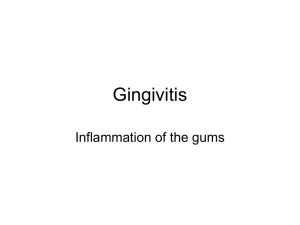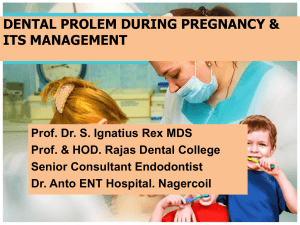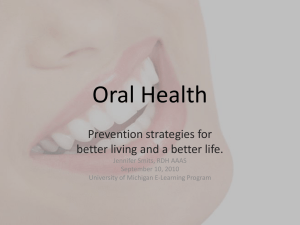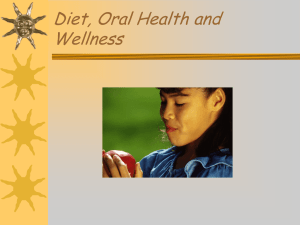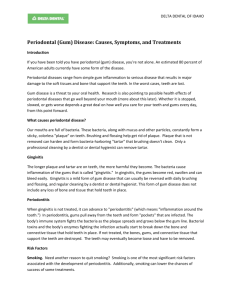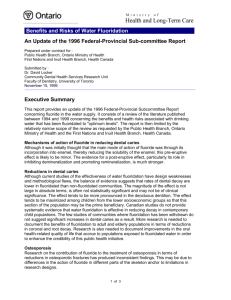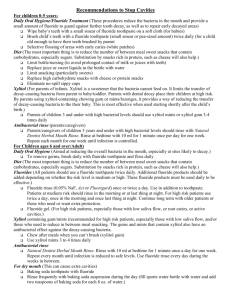Taalibah`s Myrrh Toothpowder
advertisement
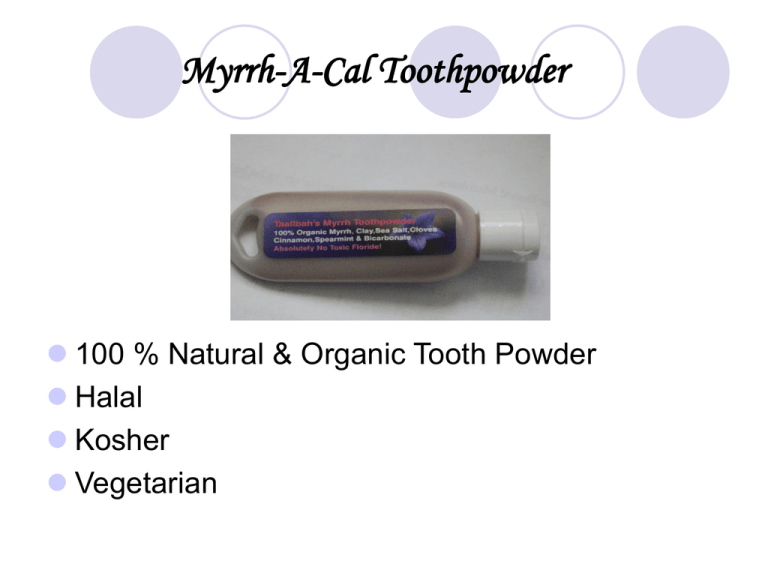
Myrrh-A-Cal Toothpowder 100 % Natural & Organic Tooth Powder Halal Kosher Vegetarian What is Gum Disease? In the broadest sense, the term gum disease--or periodontal disease-describes bacterial growth and production of factors that gradually destroy the tissue surrounding and supporting the teeth. "Periodontal" means "around the tooth." Gum disease begins with plaque, which is always forming on your teeth, without you even knowing it. When it accumulates to excessive levels, it can harden into a substance called tartar (calculus) in as little as 24 hours. Tartar is so tightly bound to teeth that it can be removed only during a professional cleaning. Gingivitis and periodontitis are the two main stages of gum disease. Each stage is characterized by what a dentist sees and feels in your mouth, and by what's happening under your gum line. Although gingivitis usually precedes periodontitis, it's important to know that not all gingivitis progresses to periodontitis. In the early stage of gingivitis, the gums can become red and swollen and bleed easily, often during tooth brushing. Bleeding, although not always a symptom of gingivitis, is a signal that your mouth is unhealthy and needs attention. The gums may be irritated, but the teeth are still firmly planted in their sockets. No bone or other tissue damage has occurred at this stage. Although dental disease in America remains a serious public health concern, recent developments indicate that the situation is far from hopeless. Signs and symtoms Periodontal disease may progress painlessly, producing few obvious signs, even in the late stages of the disease. Then one day, on a visit to your dentist, you might be told that you have chronic gum disease and that you may be at increased risk of losing your teeth. Although the symptoms of periodontal disease often are subtle, the condition is not entirely without warning signs. Certain symptoms may point to some form of the disease. They include: gums that bleed during and after tooth brushing red, swollen or tender gums persistent bad breath or bad taste in the mouth receding gums formation of deep pockets between teeth and gums loose or shifting teeth changes in the way teeth fit together on biting, or in the fit of partial dentures. Natural vs. Toxic Floride Another potential side effect of fluoride toothpaste has only recently come to light. Research conducted in the 1990s from the US pharmaceutical company Sepracor indicated that the levels of fluoride in toothpaste may be sufficient to cause or contribute to periodontal bone loss. Sepracor's finding is serious because periodontal bone loss is the #1 cause of tooth loss among adults. According to the scientists at Sepracor who conducted the study: "We have found that fluoride, in the concentration range in which it is employed for the prevention of dental caries, stimulates the production of prostaglandins and thereby exacerbates the inflammatory response in gingivitis and periodontitis.... Thus, the inclusion of fluoride in toothpastes and mouthwashes for the purpose of inhibiting the development of caries [cavities] may, at the same time, accelerate the process of chronic, destructive periodontitis." Why the Warning? One of the little-known facts about fluoride toothpaste, is that each tube of toothpaste - even those specifically marketed for children - contains enough fluoride to kill a child. As detailed below, most "Colgate for Kids" toothpastes - with flavors ranging from bubble gum to watermelon - contain 143 milligrams (mg) of fluoride in each tube. This dose of fluoride is more than double the dose (60 mg) that could kill the average-weighing 2 year old child. It is also greater than the dose capable of killing all average weighing children under the age of 9. Fortunately, however, toothpaste-induced fatalities have been rarely reported in the US. In a review of Poison Center Control reports between 1989 and 1994, 12,571 reports were found from people who had ingested excess toothpaste. Of these calls, 2 people - probably both children experienced "major medical outcomes", defined as "signs or symptoms that are life-threatening or result in significant residual disability or disfigurement" (SOURCE: Shulman 1997). References: Akiniwa, K. (1997). Re-examination of acute toxicity of fluoride. Fluoride 30: 89-104. Gessner BD, et al. (1994). Acute fluoride poisoning from a public water system. New England Journal of Medicine 330:95-9. Levy SM, Guha-Chowdhury N. (1999). Total fluoride intake and implications for dietary fluoride supplementation. Journal of Public Health Dentistry 59: 211-23. Spak CJ, et al. (1990). Studies of human gastric mucosa after application of 0.42% fluoride gel. Journal of Dental Research 69:426-9. Shulman JD, Wells LM. (1997). Acute fluoride toxicity from ingesting home-use dental products in children, birth to 6 years of age. Journal of Public Health Dentistry 57: 150-8. Whitford GM. (1987). Fluoride in dental products: safety considerations. Journal of Dental Research 66: 1056-60. Myrrh Astringent: Myrrh Essential Oil is an astringent. It strengthens hold of gums on teeth, contracts skin, muscles, intestines and other internal organs. It also affirms grip of scalp on hair roots, thereby preventing hair fall. One more serious use of this property can be seen in stopping bleeding, when this astringency makes the blood vessels to contract and checks flow of blood. Cinnamon Cinnamon has extremely high anti-oxidant activity, and the oil of cinnamon has strong anti-bacterial and anti-fungal properties. Cinnamon is also a great source of manganese, fiber, iron, and calcium. As a result, it has been used as an effective home remedy for: Reducing blood sugar levels and treating Type 2 Diabetes. Lowering cholesterol. Aiding digestion. Treating diarrhea. Curing the common cold. Reducing arthritis pain. Boosting memory and cognitive function. Treating toothaches. Eliminating bad breath. Curing headaches and migraine pain. Clove Dental Care: The most prominent use of clove oil is in dental care. The germicidal properties of the oil make it very effective for relieving dental pain, tooth ache, sore gums and mouth ulcers. Clove oil contains the compound eugenol, which has been used in dentistry since numerous years. Gargles with diluted clove oil help in easing the throat. The characteristic smell of clove oil helps removing bad breath. As a result, clove oil is added to numerous dental products and medications, including, mouth washes, and tooth pastes. Dentists also mix clove oil with zinc oxide and prepare a white filling material as a temporary alternative to root canal. Bicarbonate of soda Bicarbonate of soda, commonly known as baking soda, has long been used as a cleaning agent, but it also possesses remarkable health benefits. Bicarbonate of soda raises the blood's pH, creating an alkaline environment that fights infection and disease. Ginger Ginger oil used for massage can help relieve painful arthritis due to its antiinflammatory properties. Ginger is often included in many herbal decongestants and can help to minimise the symptoms of respiratory conditions, colds and allergies Spearmint Spearmint is native to the Mediterranean region and was cultivated throughout the Roman Empire. The Spearmint plant grows to about two feet in height, with short, bright green leaves and small, compactly-arranged flowers. Spearmint is easy to cultivate and grows well in most types of soil and is, in fact, sometimes considered a weed in America. Today, Spearmint is used for culinary purposes by people across the world. The leaf is used as a flavoring in many dishes, candies and beverages, and it is also an ingredient in cosmetics. Medicinally, Spearmint Leaf is similar to Peppermint in action, though it is considered to be milder. For this reason, Spearmint Leaf has traditionally been used in treating stomachaches in children. A decoction of Spearmint Leaf was formerly gargled to prevent gum disease and whiten the teeth, and it is still used in many toothpastes. Spearmint Leaf is primarily used to relieve ailments of the digestive tract, including indigestion, flatulence, vomiting, colic and hiccoughs. It has also been used as a mild diuretic, anti-inflammatory, and as a fever reducer. How does calcium Bentonite clay work? Bentonite clay carries a uniquely strong negative ionic charge which causes it to `magnetically` attract any substance with a positive ionic charge (i.e., bacteria, toxins, metals, etc.). These substances are both adsorbed (sticking to the outside like Velcro) and absorbed (drawn inside) by the clay molecules. Your body doesn`t digest clay, so the clay passes through your system, collecting the toxins, and removing them as the clay is eliminated. It`s like a little internal vacuum cleaner. Calcium Citrate Calcium is a key mineral in the human body, necessary for the normal growth and development of the skeleton as well as for teeth, nerve, muscle and enzyme functions. As the body’s calcium absorption capabilities reduce with age, it is vital for older individuals to have a sufficient calcium intake. Calcium requirements vary throughout an individual’s life and for different population groups. However, it is generally evident that a significant proportion of the population in Western countries fails to achieve the recommended calcium intakes. Poor dietary habits are seen to be responsible for this situation, especially when fast-food consumption dominates much of the population’s menu. Fine Sea Salt Used as a mineral rich, plaque and tartar remover Stimulates circulation and digestion Anti- bacterial, anti-fungal Mild abrasive, dissolving properties

